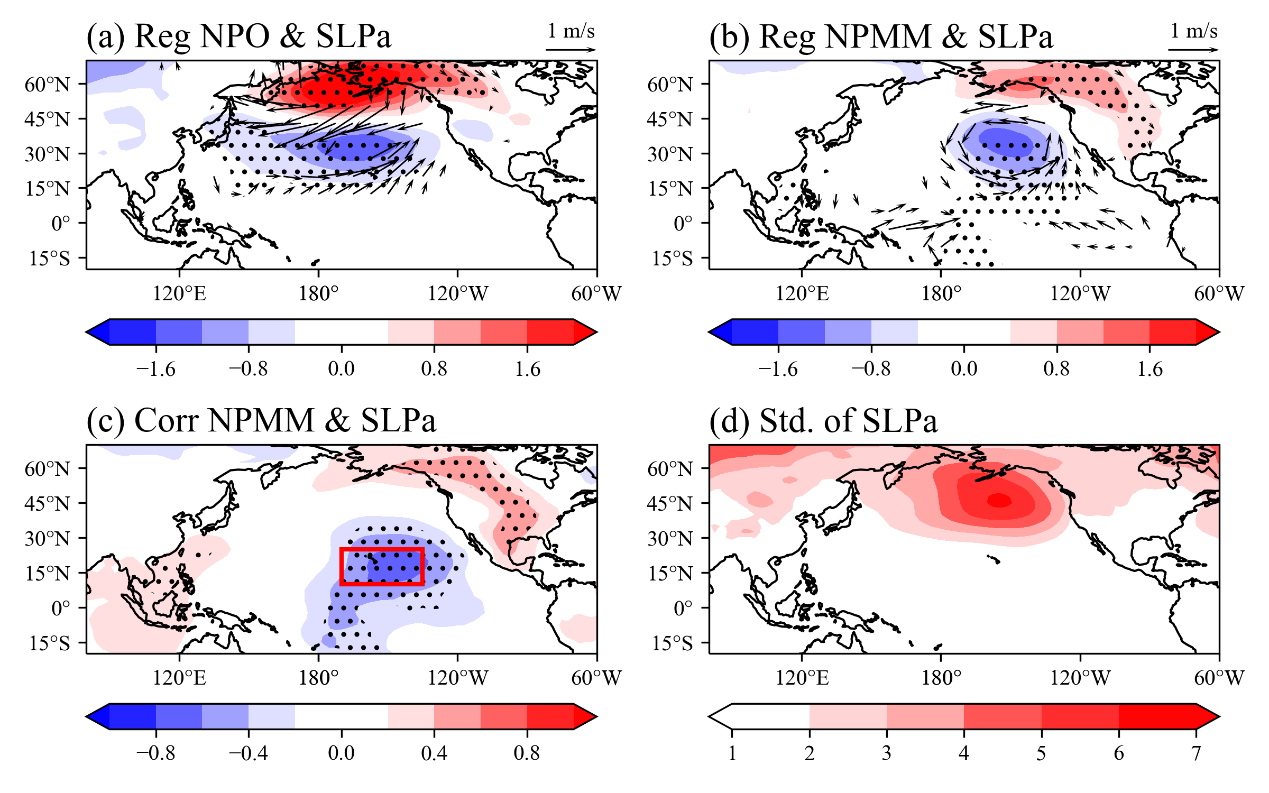The North Pacific Meridional Mode (NPMM) represents the dominant mode of coupled ocean-atmosphere variability in the subtropical northeastern Pacific. The spring NPMM significantly influences the evolution of the ENSO. NPMM events can be triggered by tropical sea surface temperature anomalies or extratropical stochastic atmospheric processes. The wintertime North Pacific Oscillation (NPO) is recognized as the primary driver for the spring NPMM formation (Figure 1a, b).
However, recent studies suggest that the NPO alone cannot fully explain the source of the NPMM, as other extratropical atmospheric modes demonstrate comparable predictability for the NPMM. Key questions thus emerge: What constitutes the critical atmospheric signal in triggering the NPMM? How can we interpret the diversity of extratropical atmospheric sources in initiating the NPMM? Furthermore, does common mechanism exists between the NPMM related to extratropical stochastic atmospheric processes and the tropical SST-induced NPMM?
Ph.D. candidate Yiming Wang and Professor Ming Bao identify that the standard deviation of sea level pressure (SLP) variability in the mid to high latitudes of the North Pacific significantly exceeds that in low latitudes (Figure 1d). This implies that the regressed SLP anomalies form January to March preceding the spring NPMM index likely amplify the mid to high latitudes signals while attenuating low latitudes signals, manifesting as an extratropical SLP pattern resembling with the NPO. Correlation analysis reveals that SLP variability over the Hawaiian region in low latitudes exhibits the strongest correlation with the spring NPMM (Figure 1c).
The study further demonstrates that SLP anomalies over the Hawaiian Islands can independently initiate the NPMM formation without NPO involvement, whereas the reverse does not hold. This indicates that extratropical atmospheric modes over the North Pacific, including the NPO, actually initiate the NPMM by spatially targeting the critical Hawaiian region through partial overlap. This mechanism suggests that a non-canonical NPO may more effectively initiate the NPMM than its canonical counterpart. Comparative analysis of atmospheric reanalysis and CMIP6 model outputs confirms the essential and independent role of Hawaiian SLP anomalies in both observations and model simulations. Additionally, the origins of these critical SLP anomalies and potential connections between the NPMM and Central Pacific ENSO events are investigated.
This research proposes a novel perspective on the NPMM triggering mechanism, providing valuable insights for future studies on NPMM-ENSO dynamics, extratropical atmosphere-ENSO interactions, and related physical processes. The finding offers significant reference for advancing mechanistic understanding in these critical areas of climate research.
Paper information:
Wang, Y., and M. Bao, 2025: Anomalous Hawaiian Sea Level Pressure Is Key to Initiate the North Pacific Meridional Mode. J. Climate, 38, 203–217, https://doi.org/10.1175/JCLI-D-23-0753.1.

Figure 1. Regression maps of the January to March SLP anomalies (shadings; unit: hPa) and surface wind anomalies (vectors; unit: m/s) onto the (a) January to March NPO index and (b) March to May NPMM index. (c) The distribution of the correlation coefficients between the January to March SLP anomalies and the March to May NPMM index (shadings). (d) The standard deviation of the January to March SLP anomalies (shadings).
